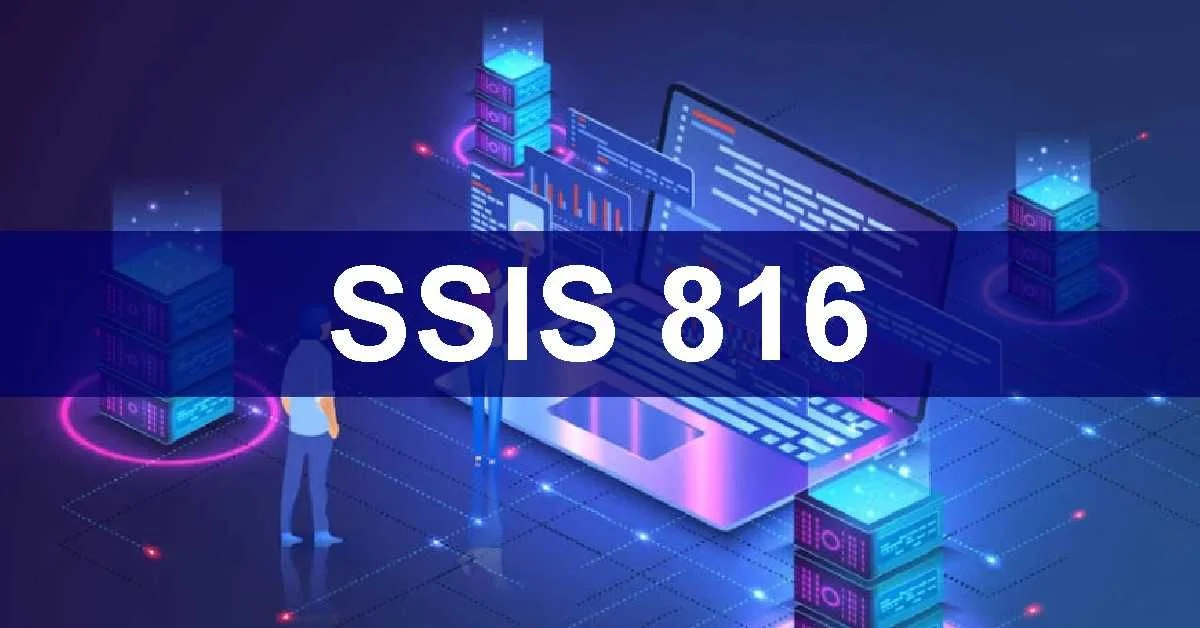SSIS 816: A Comprehensive Guide to Microsoft’s Data Integration Tool

SQL Server Integration Services (SSIS) 816 represents a sophisticated evolution in the world of data management, emphasizing robust, scalable solutions for complex Extract, Transform, and Load (ETL) operations. Developed by Microsoft, SSIS 816 forms an integral part of the SQL Server suite, designed to aid enterprises in the seamless integration and transformation of data from a variety of sources. This article delves into the multiple facets of SSIS 816, outlining its features, installation processes, and practical applications in modern data-centric environments.
What is SSIS 816?
SSIS, or SQL Server Integration Services, serves as a pivotal component in managing ETL processes, facilitating the efficient migration and transformation of data. SSIS 816, the latest iteration, extends this capability, providing enhanced tools and features for data integration. This version, refined over years of development since the inception of SSIS in 2005, offers unparalleled support for data integration tasks ranging from simple data migration to complex enterprise-level data warehousing.
Key Features of SSIS 816
Data Transformation: SSIS 816 includes a wide array of transformations such as merging, joining, and aggregating data, which can be easily configured through its intuitive graphical interface.
Connection Managers: These components enable SSIS 816 to connect to different data sources, ensuring seamless data extraction and loading across diverse environments.
Control Flow and Data Flow Tasks: These allow users to create complex ETL workflows that control the sequence of operations and the data manipulation processes within the package.
Incremental Load Support: The Change Data Capture (CDC) feature facilitates the incremental loading of data, optimizing the data synchronization and refresh processes.
Deployment Wizard and Project Deployment Model: These features simplify the deployment of SSIS projects and manage versions of deployed packages, enhancing the management of production environments.
Installing and Setting Up SSIS 816
Download SQL Server Data Tools (SSDT): Begin by downloading SSDT, which includes support for SSIS 816, from the official Microsoft website. SSDT is available for Visual Studio and includes templates and tools necessary for developing SSIS packages.
Install SQL Server and SSDT: If you haven’t already, install Microsoft SQL Server, which is required to use SSIS 816. During the SQL Server installation, select the ‘SQL Server Data Tools’ option, which will install the necessary components for SSIS.
Configure SQL Server Integration Services: After installation, configure the SQL Server Integration Services service in SQL Server Configuration Manager. This step ensures that the SSIS service runs correctly and can execute packages on the server.
Set Up the SSIS Catalog: For project deployment models, create and configure the SSISDB catalog in SQL Server Management Studio (SSMS). This catalog will store, manage, and secure your SSIS packages and projects.
Verify Installation: Open Visual Studio and check for the ‘Integration Services Project’ template under the New Project options to confirm that SSIS has been properly integrated. This verification confirms that you can begin developing SSIS packages.
Install Additional Components and Connectors: Depending on your data integration needs, you might require additional components or connectors that are not installed by default. These can include connectors for different data sources like SAP, Oracle, or various cloud services. These components are typically available through either Microsoft or third-party providers.
Configure Package Properties and Project Parameters: Before you start creating SSIS packages, configure the default properties for packages and define any necessary project parameters. This setup can include setting default logging options, and security features, or specifying connection managers that can be reused across multiple packages.
Test Your Setup: Create a simple ETL package to test your setup. This test can involve extracting data from a simple source like a flat file or a single table in a database and loading it into another destination to verify that both the development environment and the SSIS runtime are configured correctly.
By following these steps, you can ensure that SSIS 816 is installed and configured properly, setting a strong foundation for building robust data integration solutions in your environment.
Building ETL Package with SSIS 816
Creating an ETL package in SSIS 816 starts with the Visual Studio IDE. Developers can drag and drop data flow components and control flow elements to orchestrate the ETL process. This process typically begins with data extraction, where SSIS connects to the source database or file system, extracts the required data, and then applies transformations like sorting, aggregating, or converting data types before loading the transformed data into a destination, such as a database or a data warehouse.
To optimize an ETL process, SSIS 816 provides features like the SSIS Performance Wizard, which guides users through the optimization of packages to ensure that they run efficiently. Understanding the data flow and eliminating bottlenecks, such as slow-running queries or inefficient transformations, can significantly enhance the performance of your ETL processes.
Benefits of SSIS 816
Enhanced Productivity: SSIS 816’s integration with Visual Studio and use of a graphical interface simplifies the ETL process, enabling developers to design workflows quickly and efficiently without extensive coding.
Flexibility in Data Handling: The tool supports a wide range of data sources, from traditional databases like SQL Server and Oracle to modern sources such as web APIs and cloud-based services, providing versatility in data integration strategies.
Advanced Performance Features: With capabilities like parallel processing and efficient memory management, SSIS 816 can handle large volumes of data, making it suitable for enterprise-scale data warehousing projects.
Robust Error Handling and Logging: SSIS 816’s comprehensive error handling allows for troubleshooting and correcting data flow issues in real time, ensuring data integrity and reliability in automated processes.
Cost-Effective Integration Solution: By consolidating various data integration functionalities into one tool, SSIS 816 reduces the need for multiple integration solutions, lowering overall IT expenses for organizations.
Common Use Cases & Troubleshooting
SSIS 816 finds its application across various domains. In data warehousing, SSIS is used to perform nightly loads of transactional data into a centralized repository. For business intelligence, it facilitates the integration and aggregation of data from multiple sources, enabling comprehensive reporting and analysis. Data migration projects benefit from SSIS’s ability to efficiently move large volumes of data between different systems or platforms.
Troubleshooting SSIS involves monitoring package execution, identifying failures, and understanding performance metrics. SSIS provides extensive logging features, which can be configured to capture detailed information about package execution, helping to quickly identify and resolve issues. Optimizing SSIS packages may involve tuning SQL queries, redesigning the data flow, or utilizing caching to improve performance.
SSIS 816 seamlessly integrates with other Microsoft technologies, including Azure Data Factory for cloud-based data integration solutions, and SQL Server Analysis Services for advanced analytical operations. This interoperability extends SSIS’s capabilities, allowing it to serve as a bridge between on-premise data solutions and modern cloud-based platforms.
Future Trends and Updates
As the data landscape continues to evolve, SSIS 816 is expected to incorporate significant advancements to address new challenges and leverage emerging technologies. Here are some key trends and future directions:
Increased Integration with Cloud Services: As businesses continue to migrate more of their operations and data storage to the cloud, SSIS 816 is expected to enhance its integration capabilities with cloud platforms like Microsoft Azure and AWS. This includes better support for cloud data sources, seamless data movement between on-premises and cloud environments, and tools to manage ETL processes that span across hybrid environments.
Real-Time Data Processing: There is a growing demand for real-time data processing capabilities within ETL tools to support time-sensitive decision-making and operations. Future versions of SSIS are likely to include more robust options for streaming data integration, allowing businesses to process and analyze data as it arrives, rather than in batches.
Artificial Intelligence and Machine Learning Integration: SSIS 816 is set to expand its AI and machine learning functionalities, potentially integrating with Azure Machine Learning and other AI platforms to enable more sophisticated data transformations and analytics directly within ETL workflows. This integration will help automate complex data processing tasks, such as predictive modeling and anomaly detection, within SSIS packages.
Enhanced Security Features: As data breaches and security threats become more prevalent, SSIS will likely bolster its security features to protect sensitive data during transfer and processing. This includes improved encryption methods, enhanced data masking capabilities, and better compliance tools to meet global data protection regulations.
User Interface Improvements: To further lower the barrier to entry and improve user experience, future updates of SSIS might focus on enhancing the graphical interface, making it more intuitive and accessible for users without deep technical expertise. These improvements could include smarter workflow designers, better visualization of data flows, and enhanced debugging tools.
Greater Customizability and Extensibility: Recognizing the diverse needs of its user base, SSIS is expected to become more customizable and extensible. This means more open APIs, custom components, and plug-ins developed by both Microsoft and third-party vendors to extend the functionality of SSIS to meet specific industry needs.
Sustainability and Green Computing: As part of Microsoft’s broader sustainability efforts, future developments in SSIS might also focus on optimizing resource utilization and reducing the environmental impact of data operations. This could involve more efficient data processing techniques and tools to monitor and minimize the energy consumption of data centers.
These trends and updates will not only enhance the capabilities of SSIS 816 but also ensure it remains a vital tool for organizations looking to innovate and improve their data integration strategies in an increasingly data-driven world. As SSIS continues to evolve, it will provide enterprises with the tools they need to efficiently manage and analyze their data, ensuring they stay ahead in the competitive landscape.
Conclusion
SSIS 816 is a powerful, versatile tool essential for any organization dealing with large amounts of data or requiring complex data integration solutions. Its comprehensive feature set, combined with robust error handling, advanced data transformation capabilities, and integration with other Microsoft tools, makes it an indispensable asset for efficient, reliable data management.
FAQs
Q1: What is SSIS 816 used for? A1: SSIS 816 is used for data integration, including ETL processes to extract, transform, and load data between various data sources and systems.
Q2: Can SSIS 816 handle large data sets? A2: Yes, SSIS 816 is designed for performance and scalability, capable of handling large datasets efficiently through features like parallel processing.
Q3: Is coding required to use SSIS 816? A3: While some advanced tasks might require coding, SSIS 816 generally allows users to build data integration solutions visually without extensive programming.
Q4: How does SSIS 816 ensure data accuracy? A4: SSIS 816 includes robust error handling and data cleansing features, ensuring that data remains accurate and consistent during integration processes.
Q5: Can SSIS 816 integrate data from cloud sources? A5: Yes, SSIS 816 can connect to cloud-based data sources, facilitating the integration of on-premises data with cloud platforms like Microsoft Azure.
For more information, Visit Celebrity World



